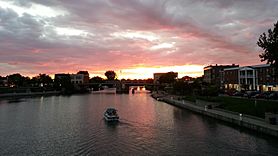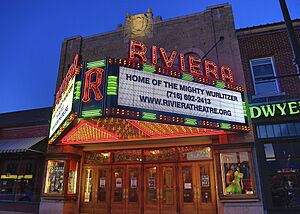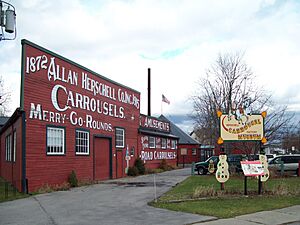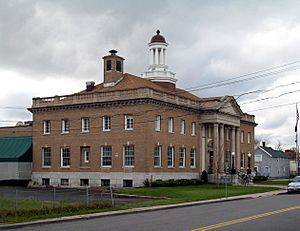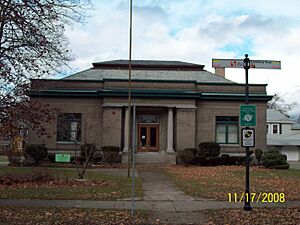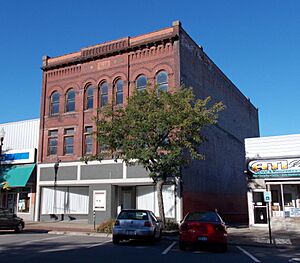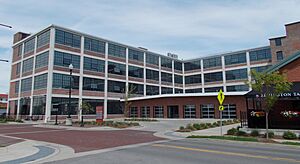North Tonawanda, New York facts for kids
Quick facts for kids
North Tonawanda
|
||
|---|---|---|
| City of North Tonawanda | ||
|
Left to right from top: Gateway Harbor, Herschell Carrousel Factory Museum, Riviera Theatre
|
||
|
||
| Nickname(s):
N.T.
|
||
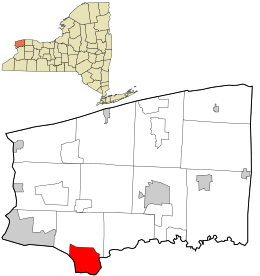
Location in Niagara County and the state of New York
|
||
| Country | United States | |
| State | New York | |
| County | Niagara | |
| Government | ||
| • Type | Mayor-Council | |
| Area | ||
| • Total | 10.89 sq mi (28.22 km2) | |
| • Land | 10.09 sq mi (26.14 km2) | |
| • Water | 0.80 sq mi (2.08 km2) | |
| Elevation | 574 ft (175 m) | |
| Population
(2020)
|
||
| • Total | 30,496 | |
| • Density | 3,021.50/sq mi (1,166.62/km2) | |
| Time zone | UTC-5 (Eastern (EST)) | |
| • Summer (DST) | UTC-4 (EDT) | |
| ZIP code |
14120
|
|
| Area code(s) | 716 | |
| FIPS code | 36-53682 | |
| GNIS feature ID | 0958935 | |
North Tonawanda is a city in Niagara County, New York, United States. In 2020, about 30,496 people lived there. It is part of the larger Buffalo-Niagara Falls metropolitan area. The city gets its name from Tonawanda Creek, which forms its southern border.
The word "Tonawanda" comes from the Seneca language and means "swift-running water." Tonawanda Creek used to have many fast-moving parts. These rapids were changed when the Erie Canal was built.
North Tonawanda is also known as the "Lumber City." This is because the lumber industry was very important there in the past. It was once a major port on the Great Lakes when the Erie Canal was busy. Many grand houses built for wealthy lumber business owners can still be seen on Goundry Street. Some people call the city the "Jewel of Niagara County." This is because it is located between the Niagara River and the Erie Canal. Signs at the city's borders welcome visitors to the "Home of the Carousel."
Contents
History of North Tonawanda
The first settlers arrived in the area in 1809. North Tonawanda became part of the town of Wheatfield, New York, in 1836. It officially became a village on May 8, 1865. Later, on April 24, 1897, North Tonawanda was made a city.
North Tonawanda is located on the north side of the Erie Canal and Tonawanda Creek. It is across from the City of Tonawanda and the Town of Amherst. The Niagara River is to its west. North Tonawanda is the second-largest city in Niagara County.
The "Lumber City" and Carousels
North Tonawanda earned its nickname "Lumber City" because it was a major center for transporting and processing lumber. This was especially true from the mid-1800s to the 1970s. The city was also the birthplace of the Herschell-Spillman Company/Allan Herschell Co.. This company was one of America's top makers of carousels. Today, you can visit the Herschell Carrousel Factory Museum there.
In 1888, a Belgian inventor named Eugene de Kleist came to North Tonawanda. He started the North Tonawanda Barrel Organ Factory to make band organs. Later, in 1909, the Rudolph Wurlitzer Company took over. Wurlitzer became one of the biggest musical instrument factories in the world. Many other successful businesses, like Ray H. Bennett Lumber Co. and Richardson Boat, also started in North Tonawanda.
Cultural Spots and Parks
North Tonawanda has many interesting places to visit. The Railroad Museum of the Niagara Frontier is in an old Erie Railroad station. The Riviera Theater and Performing Arts Center is a beautiful, restored building. It hosts plays, concerts, and movies. It also has a special 1926 "Mighty Wurlitzer" organ. The Ghostlight Theatre is a community theater in an old church. The former Carnegie Library is now the Carnegie Art Center.
The city also has several parks. Veteran's Park has monuments for U.S. Seabees and U.S. Marines. Gateway Harbor Park is along the Erie Canal. It hosts the yearly Canal Fest in July and free concerts. Gratwick-Riverside Park is a large park along the Niagara River. Other parks include Pine Woods Park, Mayor's Park, and the North Tonawanda Botanical Gardens.
Geography of North Tonawanda
North Tonawanda is located at 43°2′28″N 78°52′8″W / 43.04111°N 78.86889°W.
The Erie Canal forms the southern and most of the eastern borders of the city. US Route 62 is on the northeastern side. The Niagara River forms the western border. Tonawanda Island is in the southwest corner of the city. It is separated from the mainland by the Little River.
Sometimes, it can be tricky to know if you are in North Tonawanda. This is because some parts of the Towns of Wheatfield and Pendleton use the same zip code, 14120.
Climate
North Tonawanda has a climate typical of the region. It experiences warm summers and cold, snowy winters.
| Climate data for North Tonawanda, New York (1991–2020 normals, extremes 1982–present) | |||||||||||||
|---|---|---|---|---|---|---|---|---|---|---|---|---|---|
| Month | Jan | Feb | Mar | Apr | May | Jun | Jul | Aug | Sep | Oct | Nov | Dec | Year |
| Record high °F (°C) | 66 (19) |
74 (23) |
82 (28) |
93 (34) |
94 (34) |
95 (35) |
100 (38) |
97 (36) |
95 (35) |
87 (31) |
80 (27) |
72 (22) |
100 (38) |
| Mean maximum °F (°C) | 55.1 (12.8) |
55.2 (12.9) |
66.9 (19.4) |
79.2 (26.2) |
86.1 (30.1) |
90.2 (32.3) |
91.2 (32.9) |
90.3 (32.4) |
87.3 (30.7) |
78.8 (26.0) |
67.7 (19.8) |
56.5 (13.6) |
93.0 (33.9) |
| Mean daily maximum °F (°C) | 33.2 (0.7) |
35.5 (1.9) |
44.1 (6.7) |
56.9 (13.8) |
69.8 (21.0) |
78.8 (26.0) |
82.8 (28.2) |
81.5 (27.5) |
74.3 (23.5) |
61.2 (16.2) |
49.2 (9.6) |
38.0 (3.3) |
58.8 (14.9) |
| Daily mean °F (°C) | 24.9 (−3.9) |
26.2 (−3.2) |
34.0 (1.1) |
45.2 (7.3) |
57.2 (14.0) |
66.9 (19.4) |
70.9 (21.6) |
69.7 (20.9) |
62.4 (16.9) |
50.8 (10.4) |
40.0 (4.4) |
30.6 (−0.8) |
48.2 (9.0) |
| Mean daily minimum °F (°C) | 16.7 (−8.5) |
16.9 (−8.4) |
23.8 (−4.6) |
33.5 (0.8) |
44.6 (7.0) |
55.0 (12.8) |
59.1 (15.1) |
57.8 (14.3) |
50.4 (10.2) |
40.4 (4.7) |
30.7 (−0.7) |
23.1 (−4.9) |
37.7 (3.2) |
| Mean minimum °F (°C) | −0.6 (−18.1) |
0.4 (−17.6) |
7.4 (−13.7) |
22.2 (−5.4) |
32.2 (0.1) |
42.4 (5.8) |
49.6 (9.8) |
47.9 (8.8) |
37.4 (3.0) |
27.8 (−2.3) |
18.4 (−7.6) |
7.1 (−13.8) |
−4.0 (−20.0) |
| Record low °F (°C) | −12 (−24) |
−15 (−26) |
−8 (−22) |
15 (−9) |
25 (−4) |
35 (2) |
41 (5) |
36 (2) |
27 (−3) |
21 (−6) |
10 (−12) |
−9 (−23) |
−15 (−26) |
| Average precipitation inches (mm) | 3.19 (81) |
2.44 (62) |
2.94 (75) |
3.64 (92) |
3.38 (86) |
3.30 (84) |
3.46 (88) |
3.10 (79) |
3.90 (99) |
3.94 (100) |
3.46 (88) |
3.39 (86) |
40.14 (1,020) |
| Average snowfall inches (cm) | 22.9 (58) |
16.1 (41) |
13.1 (33) |
2.7 (6.9) |
0.0 (0.0) |
0.0 (0.0) |
0.0 (0.0) |
0.0 (0.0) |
0.0 (0.0) |
0.5 (1.3) |
6.0 (15) |
18.5 (47) |
79.8 (203) |
| Average extreme snow depth inches (cm) | 9.5 (24) |
9.1 (23) |
7.9 (20) |
1.0 (2.5) |
0.0 (0.0) |
0.0 (0.0) |
0.0 (0.0) |
0.0 (0.0) |
0.0 (0.0) |
0.2 (0.51) |
2.4 (6.1) |
6.7 (17) |
13.3 (34) |
| Average precipitation days (≥ 0.01 in) | 20.0 | 15.8 | 15.1 | 14.3 | 13.3 | 12.3 | 11.2 | 10.6 | 11.3 | 14.6 | 14.5 | 18.2 | 171.2 |
| Average snowy days (≥ 0.1 in) | 16.5 | 13.1 | 8.4 | 3.0 | 0.0 | 0.0 | 0.0 | 0.0 | 0.0 | 0.2 | 4.6 | 11.6 | 57.4 |
| Source: NOAA | |||||||||||||
Important Buildings and Sites
North Tonawanda has many old and interesting buildings. Some of them are listed on the National Register of Historic Places. The old Wurlitzer Organ Factory building is now used by different businesses.
The North Tonawanda City Market started in 1908. It is the oldest farmer's market in Niagara County. Farmers sell their goods there three days a week all year. It is busiest in the summer and early fall.
Historic Places to Visit
Here are some important historic sites in North Tonawanda:
| Site name | Image | Location | Date added | |
|---|---|---|---|---|
| 1 | Riviera Theatre | 67 Webster Street | March 20, 1980 | |
| 2 | Herschell Carrousel Factory Museum | 180 Thompson St. | April 18, 1985 | |
| 3 | United States Post Office | 141 Goundry St. | May 11, 1989 | |
| 4 | Carnegie Library | 249 Goundry St. | July 14, 1995 | |
| 5 | Dick Block | 62 Webster St. | November 21, 2012 | |
| 6 | Herschell–Spillman Motor Company complex |
184 Sweeney St. | June 5, 2013 |
Population of North Tonawanda
| Historical population | |||
|---|---|---|---|
| Census | Pop. | %± | |
| 1880 | 1,492 | — | |
| 1890 | 4,793 | 221.2% | |
| 1900 | 9,069 | 89.2% | |
| 1910 | 11,955 | 31.8% | |
| 1920 | 15,482 | 29.5% | |
| 1930 | 19,019 | 22.8% | |
| 1940 | 20,254 | 6.5% | |
| 1950 | 24,731 | 22.1% | |
| 1960 | 34,757 | 40.5% | |
| 1970 | 36,012 | 3.6% | |
| 1980 | 35,760 | −0.7% | |
| 1990 | 34,989 | −2.2% | |
| 2000 | 33,262 | −4.9% | |
| 2010 | 31,568 | −5.1% | |
| 2020 | 30,496 | −3.4% | |
| U.S. Decennial Census | |||
In 2000, there were 33,262 people living in North Tonawanda. There were 13,671 households and 8,981 families. The city had about 3,293 people per square mile.
Most of the people living in the city were White (97.86%). A small number were African American (0.29%), Native American (0.34%), or Asian (0.53%). About 1.09% of the population was Hispanic or Latino.
About 30.2% of households had children under 18. The average household had 2.43 people. The average family had 3.03 people. The median age in the city was 38 years old.
Schools in North Tonawanda
The public schools in North Tonawanda include:
- North Tonawanda High School
- North Tonawanda Middle School
- Drake Elementary School
- North Tonawanda Intermediate School
- Spruce Elementary School
- Ohio Elementary School
City Services
North Tonawanda provides important services for its residents:
- North Tonawanda City School District
- North Tonawanda Police Department
- North Tonawanda Public Library
- DeGraff Memorial Hospital, which is part of Kaleida Health
- North Tonawanda Fire Department: This department has both full-time firefighters and volunteers. They operate from five stations with different fire trucks and equipment.
Famous People from North Tonawanda
Many notable people have come from North Tonawanda:
- Ted Barrett, a baseball umpire
- Rudy Bozak, a famous engineer
- Cindy Bradley, a jazz trumpet player
- Jim Britton, a retired baseball pitcher
- Rita Kogler Carver, a studio designer
- Eugene de Kleist, an organ builder
- Maryalice Demler, a former Miss New York
- Tonio di Paolo, an opera singer
- Phil Fasciana, a death metal guitarist
- Ed Harmon, a professional football player
- Bret Hoffmann, a death metal vocalist
- Jim Hurtubise, an automobile racer
- Edward C. Kuhn, a U.S. military designer
- William Larson, a photographer
- Robert Mangold, an artist
- George D. Maziarz, a politician
- Bernard Joseph McLaughlin, a bishop
- Hans Oldag, a long-distance runner
- Jamin Olivencia, a professional wrestler
- John Olszowka, a historian
- Robert G. Ortt, a politician
- Gladys Parker, a comic-strip artist
- Lewis S. Payne, a former New York state senator
- Roman Piskor, an NFL football player
- James Rand Jr., an industrialist
- Stan Rojek, a baseball player
- Geoff Sanderson, a former NHL player
- Paul Schaus, a sledge hockey gold medalist
- Robin Schimminger, a politician
- Don Smith, an Olympic rower
- Henry P. Smith III, a politician
- Paul Van Arsdale, a hammered dulcimer player
- Christopher J. Waild, a screenwriter
- Andy Williams, a guitarist in Every Time I Die
See also
 In Spanish: North Tonawanda para niños
In Spanish: North Tonawanda para niños
- Tonawanda (disambiguation)


